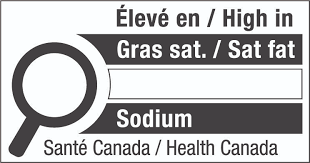Over the last week, I had the pleasure to speak about the new front-of-package nutrition labels that will be required on all packaged foods starting January 1, 2026. These radio interviews were hosted by Catherine Morasse (Le réveil / Nouvelle-Écosse et T.-N.) and Laurent Rigaux (Le réveil / Île-du-Prince-Édouard).
I’ve prepared a summary for you, or if you prefer, I’ve attached both the July 4 and July 7 interviews.
What is the Front-of-package nutrition symbol (FOP)?
In a nutshell, FOP nutrition symbol
- Will help us quickly and easily identify foods high in saturated fat, sugars and sodium.
- Is located on the front upper half of food packaging.
This highly visible information tool is designed to help consumers make better informed nutritional decisions by making it easier to understand the dietary value of food we eat. By simplifying the grocery store experience our goal is to encourage you to eat well, feel good, and enjoy living a better quality of life!
Will the Front-of-package nutrition symbol really affect the way we buy our food?
Chances are yes, since about 80% of Canadians say it’s important for them to make healthy choices. However, 60% of the food we buy is processed and prepackaged. These packaged foods may contain more than 15% of daily recommended intake of salt, sugar and/or saturated fat, and nutritional research has linked these elevated factors to certain types of diseases.
What are the consequences of exceeding these thresholds (15%) when it comes to salt, sugar or saturated fats?
As mentioned above frequent consumption of foods high in saturated fat, sugar or sodium is associated with certain diseases. Eating processed foods occasionally is generally considered acceptable. The problem arises when we eat them regularly several times a week, serve them to our children, and eat them again on weekends. In the long term, these ultra-processed foods can increase many types of disease, including cancer. In Canada many cancers are linked to what we eat, the good news is by adopting nutritious habits, it is possible to reduce our risk. Diseases that are linked to processed foods include lung, breast, esophageal, stomach, pancreatic and colorectal cancers, to name but a few.
And then there’s type 2 diabetes – unfortunately, being widespread in Canada, almost everyone knows someone with type 2. Hopefully, this new front of packaging label should help people with diabetes, to better understanding what they eat.
Decreasing the frequency and quantity of process foods will help us prevent and better manage:
- Diseases (chronic, cancer, etc…)
- Obesity (which is now a chronic disease recognized by the World Health Organization).
- Health strokes.
- High blood pressure.
- Many other heart diseases.
Why is this threshold set at 15%?
This threshold has been established from many detailed studies, which have demonstrated that when eating food containing elevated salt, sugar, and saturated fats (that are above 15% threshold) on a regular basis, will result in putting our health at risk.
There are also thresholds of 10% and 30% for specific food categories:
- 10% is used when the food is in very small quantities, for example, sauces or condiments such as ketchup or mustard.
- 30% for main courses, such as frozen lasagna or pizza.
Is Canada the first country to implement this new type of symbol?
Currently Canada is following the lead of Europe. Take France, for example, which developed the ‘’Nutriscore’’ which is an easy way to quantify the quality of nutrition in foods, and has been used since 2017. Nutriscore, features a colour code that’s quick and easy to use for making informed and healthy choices. It is currently used in France as well as just about everywhere else in Europe, including Portugal, Spain, Belgium, Switzerland, and Germany.
In Mexico, a black-and-white logo has been implemented since March 2020. In Canada, this new FOP labelling will be required on all packaging by January 2026 at the latest, however you may see it before then, so its never too late to improve what we eat.
Can we say that Canadians are eating well overall?
Gradually, the Canadian food industry is making efforts to reduce sugar, salt and fat, and especially saturated fat since food standards are becoming increasingly strict.
When it comes to food security, however, we still have our work cut out for us. I would say that one of the major challenges is inequality in the form of food insecurity. Unfortunately, food insecurity is on the rise, even in 2025. This means that there are still many families who lack consistent access to a sufficient, safe and nutritious food supply to meet their dietary needs. For example, many people cannot access nutrient dense food because their neighbourhood food store lacks a variety of healthy options such as fresh fruit and vegetables.
Do you think that the Front-of-package nutrition symbol will encourage food manufacturers to reduce fat, sugar and salt content in their products?
Yes, that’s for sure. I think it’s a very good initiative that will help encourage manufacturers to make better all-around nutritious food products.
The success of FOP food labelling will be possible if everyone (consumers, manufacturers, industries) contributes and gets actively involved in reinforcing the message that providing nutritious food to consumers will promote healthy eating, and as a result improve the quality of life for everyone. That’s what we nutritionists have been saying for the past 30 years: it’s important to try to eat the best you can, to take the time to cook and to eat with your family or friends too!
Thank you for taking the time to read about front-of-packaging labelling and for savouring the foods you love!
Your nutritionist and speaker,
Johanne Vézina, Dt.P.



